TUI Group Analysis: Factors Affecting Travel & Tourism Sector
VerifiedAdded on 2024/05/13
|32
|4001
|152
Report
AI Summary
This report provides a comprehensive analysis of the travel and tourism sector, focusing on the TUI Group. It begins with a historical overview of the tourism industry, highlighting key developments from ancient times to the modern era, including the emergence of grand tours and the impact of transportation advancements. The report details the structure of the tourism industry, outlining essential components such as transportation, accommodation, tour operators, travel agents, tourist attractions, and tourism development initiatives. It evaluates factors affecting the tourism sector, including economic conditions, political stability, technological advancements, social influences, legal frameworks, and environmental considerations. The report also examines the role of governmental and international bodies in promoting tourism and the impact of economic policies and political changes on the industry. Furthermore, it evaluates the positive and negative environmental, social, and economic impacts of tourism on the TUI Group's businesses and suggests strategies to minimize negative impacts and maximize positive ones. This assignment solution is available on Desklib, where students can find a wide range of academic resources, including past papers and solved assignments.
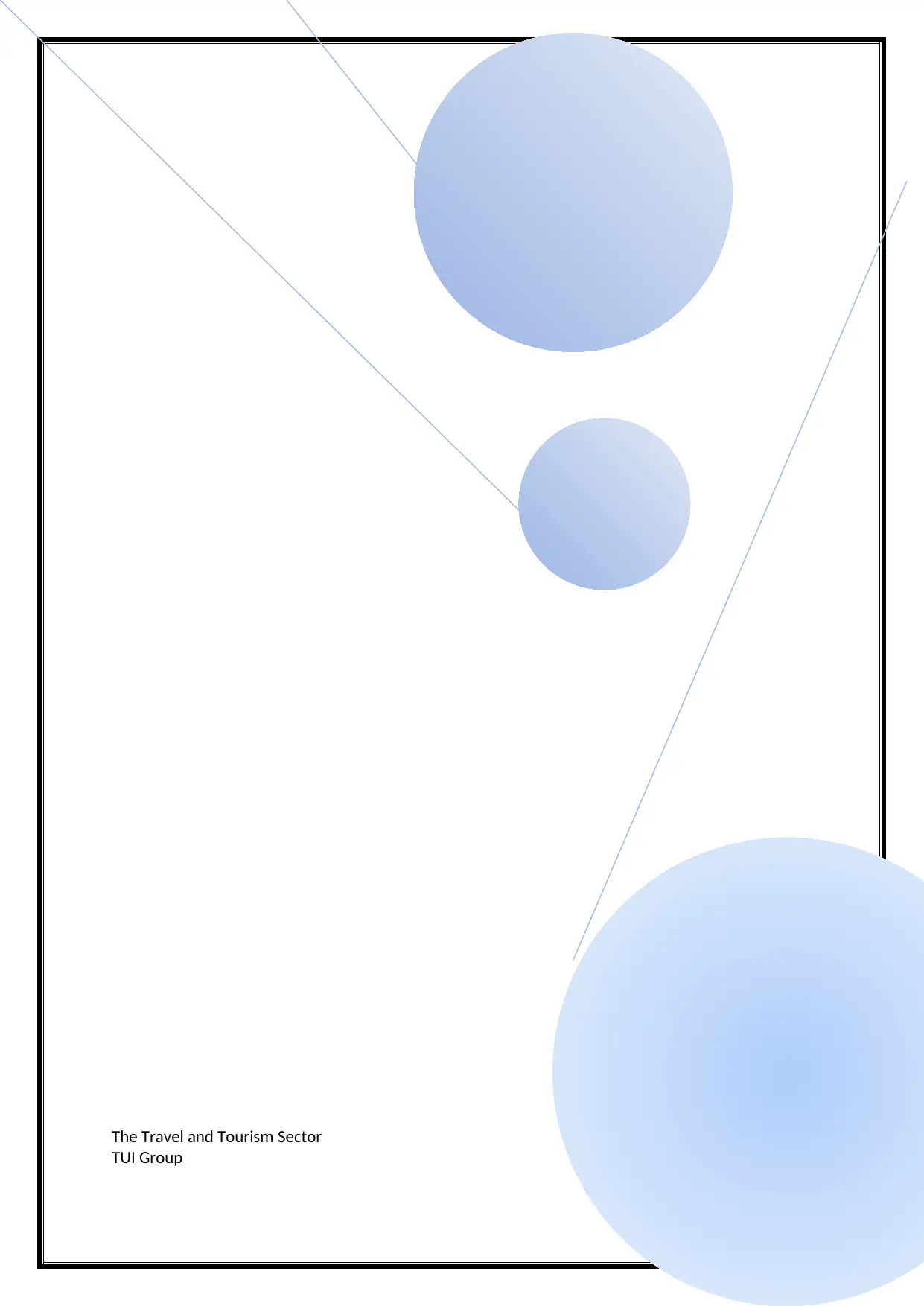
The Travel and Tourism Sector
TUI Group
TUI Group
Paraphrase This Document
Need a fresh take? Get an instant paraphrase of this document with our AI Paraphraser
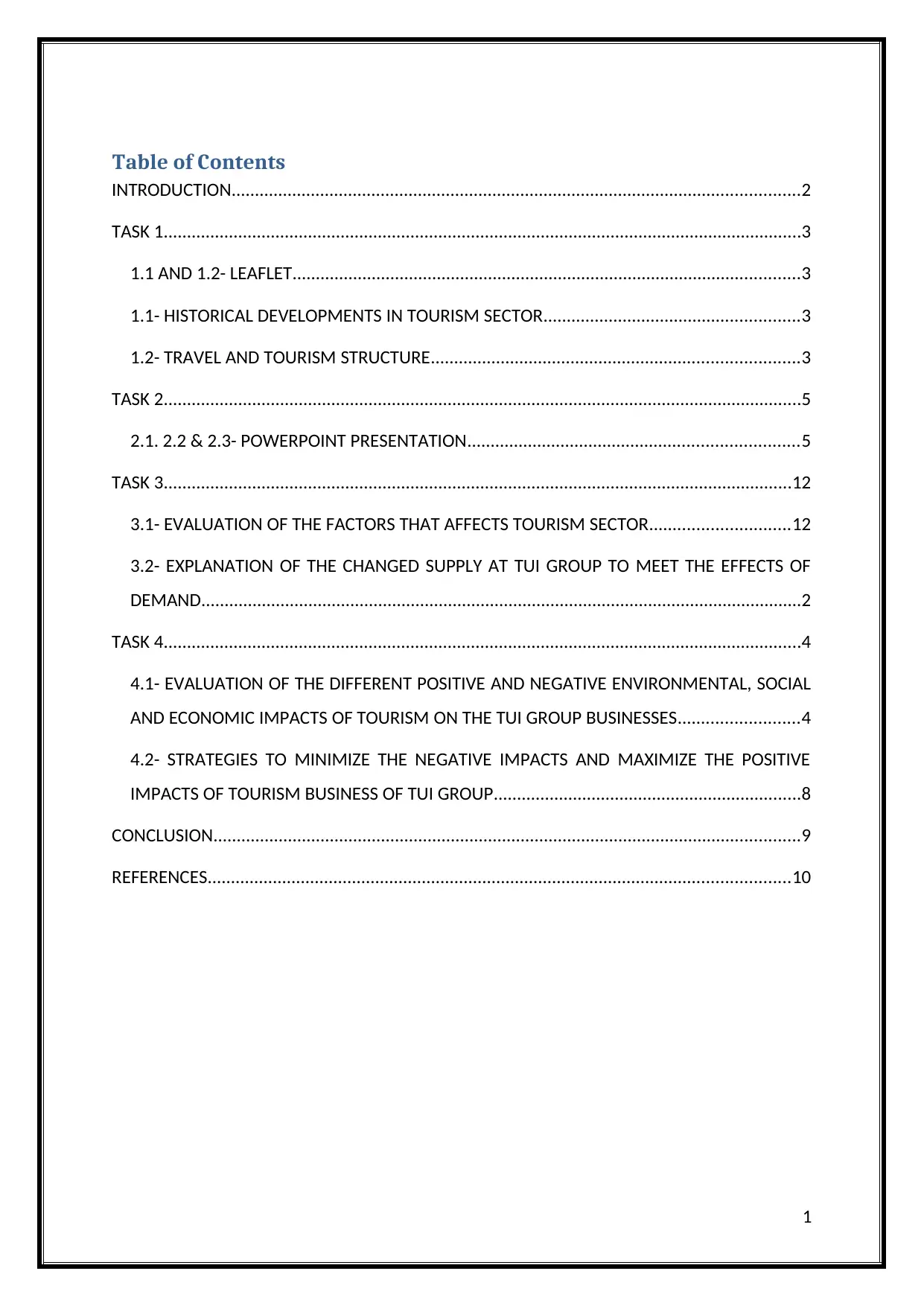
Table of Contents
INTRODUCTION..........................................................................................................................2
TASK 1.........................................................................................................................................3
1.1 AND 1.2- LEAFLET.............................................................................................................3
1.1- HISTORICAL DEVELOPMENTS IN TOURISM SECTOR.......................................................3
1.2- TRAVEL AND TOURISM STRUCTURE...............................................................................3
TASK 2.........................................................................................................................................5
2.1. 2.2 & 2.3- POWERPOINT PRESENTATION.......................................................................5
TASK 3.......................................................................................................................................12
3.1- EVALUATION OF THE FACTORS THAT AFFECTS TOURISM SECTOR..............................12
3.2- EXPLANATION OF THE CHANGED SUPPLY AT TUI GROUP TO MEET THE EFFECTS OF
DEMAND.................................................................................................................................2
TASK 4.........................................................................................................................................4
4.1- EVALUATION OF THE DIFFERENT POSITIVE AND NEGATIVE ENVIRONMENTAL, SOCIAL
AND ECONOMIC IMPACTS OF TOURISM ON THE TUI GROUP BUSINESSES..........................4
4.2- STRATEGIES TO MINIMIZE THE NEGATIVE IMPACTS AND MAXIMIZE THE POSITIVE
IMPACTS OF TOURISM BUSINESS OF TUI GROUP..................................................................8
CONCLUSION..............................................................................................................................9
REFERENCES.............................................................................................................................10
1
INTRODUCTION..........................................................................................................................2
TASK 1.........................................................................................................................................3
1.1 AND 1.2- LEAFLET.............................................................................................................3
1.1- HISTORICAL DEVELOPMENTS IN TOURISM SECTOR.......................................................3
1.2- TRAVEL AND TOURISM STRUCTURE...............................................................................3
TASK 2.........................................................................................................................................5
2.1. 2.2 & 2.3- POWERPOINT PRESENTATION.......................................................................5
TASK 3.......................................................................................................................................12
3.1- EVALUATION OF THE FACTORS THAT AFFECTS TOURISM SECTOR..............................12
3.2- EXPLANATION OF THE CHANGED SUPPLY AT TUI GROUP TO MEET THE EFFECTS OF
DEMAND.................................................................................................................................2
TASK 4.........................................................................................................................................4
4.1- EVALUATION OF THE DIFFERENT POSITIVE AND NEGATIVE ENVIRONMENTAL, SOCIAL
AND ECONOMIC IMPACTS OF TOURISM ON THE TUI GROUP BUSINESSES..........................4
4.2- STRATEGIES TO MINIMIZE THE NEGATIVE IMPACTS AND MAXIMIZE THE POSITIVE
IMPACTS OF TOURISM BUSINESS OF TUI GROUP..................................................................8
CONCLUSION..............................................................................................................................9
REFERENCES.............................................................................................................................10
1
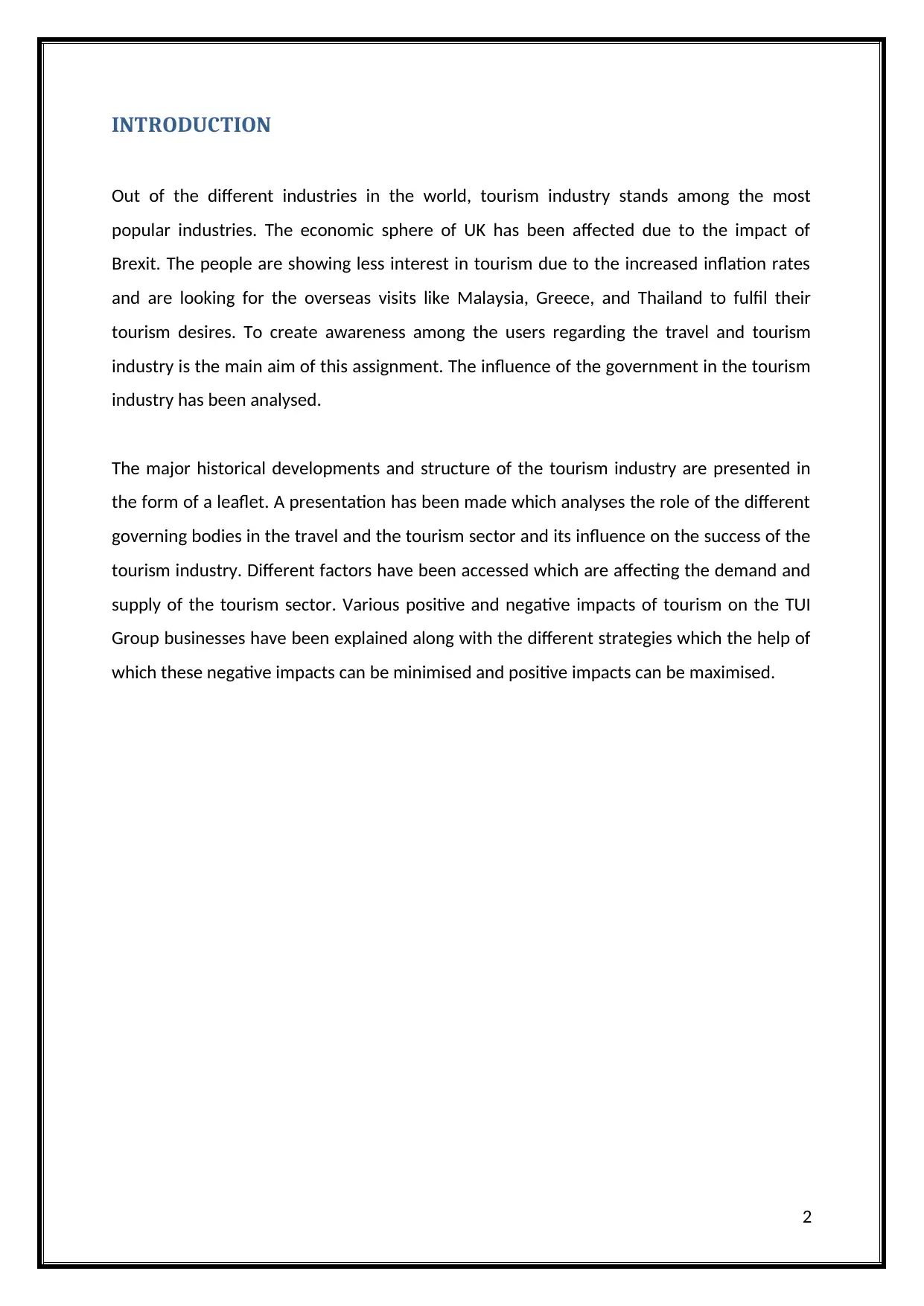
INTRODUCTION
Out of the different industries in the world, tourism industry stands among the most
popular industries. The economic sphere of UK has been affected due to the impact of
Brexit. The people are showing less interest in tourism due to the increased inflation rates
and are looking for the overseas visits like Malaysia, Greece, and Thailand to fulfil their
tourism desires. To create awareness among the users regarding the travel and tourism
industry is the main aim of this assignment. The influence of the government in the tourism
industry has been analysed.
The major historical developments and structure of the tourism industry are presented in
the form of a leaflet. A presentation has been made which analyses the role of the different
governing bodies in the travel and the tourism sector and its influence on the success of the
tourism industry. Different factors have been accessed which are affecting the demand and
supply of the tourism sector. Various positive and negative impacts of tourism on the TUI
Group businesses have been explained along with the different strategies which the help of
which these negative impacts can be minimised and positive impacts can be maximised.
2
Out of the different industries in the world, tourism industry stands among the most
popular industries. The economic sphere of UK has been affected due to the impact of
Brexit. The people are showing less interest in tourism due to the increased inflation rates
and are looking for the overseas visits like Malaysia, Greece, and Thailand to fulfil their
tourism desires. To create awareness among the users regarding the travel and tourism
industry is the main aim of this assignment. The influence of the government in the tourism
industry has been analysed.
The major historical developments and structure of the tourism industry are presented in
the form of a leaflet. A presentation has been made which analyses the role of the different
governing bodies in the travel and the tourism sector and its influence on the success of the
tourism industry. Different factors have been accessed which are affecting the demand and
supply of the tourism sector. Various positive and negative impacts of tourism on the TUI
Group businesses have been explained along with the different strategies which the help of
which these negative impacts can be minimised and positive impacts can be maximised.
2
⊘ This is a preview!⊘
Do you want full access?
Subscribe today to unlock all pages.

Trusted by 1+ million students worldwide
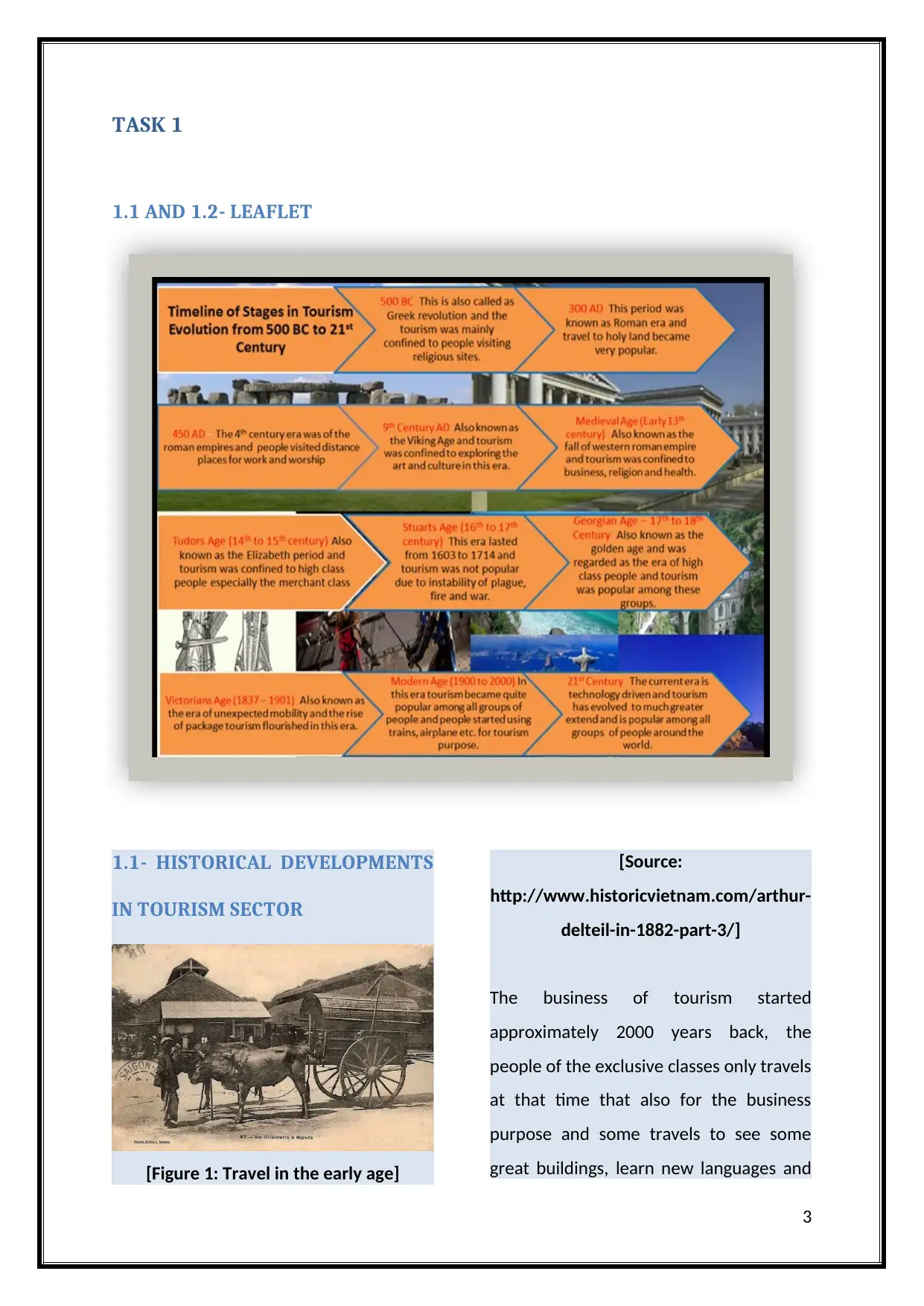
TASK 1
1.1 AND 1.2- LEAFLET
1.1- HISTORICAL DEVELOPMENTS
IN TOURISM SECTOR
[Figure 1: Travel in the early age]
[Source:
http://www.historicvietnam.com/arthur-
delteil-in-1882-part-3/]
The business of tourism started
approximately 2000 years back, the
people of the exclusive classes only travels
at that time that also for the business
purpose and some travels to see some
great buildings, learn new languages and
3
1.1 AND 1.2- LEAFLET
1.1- HISTORICAL DEVELOPMENTS
IN TOURISM SECTOR
[Figure 1: Travel in the early age]
[Source:
http://www.historicvietnam.com/arthur-
delteil-in-1882-part-3/]
The business of tourism started
approximately 2000 years back, the
people of the exclusive classes only travels
at that time that also for the business
purpose and some travels to see some
great buildings, learn new languages and
3
Paraphrase This Document
Need a fresh take? Get an instant paraphrase of this document with our AI Paraphraser
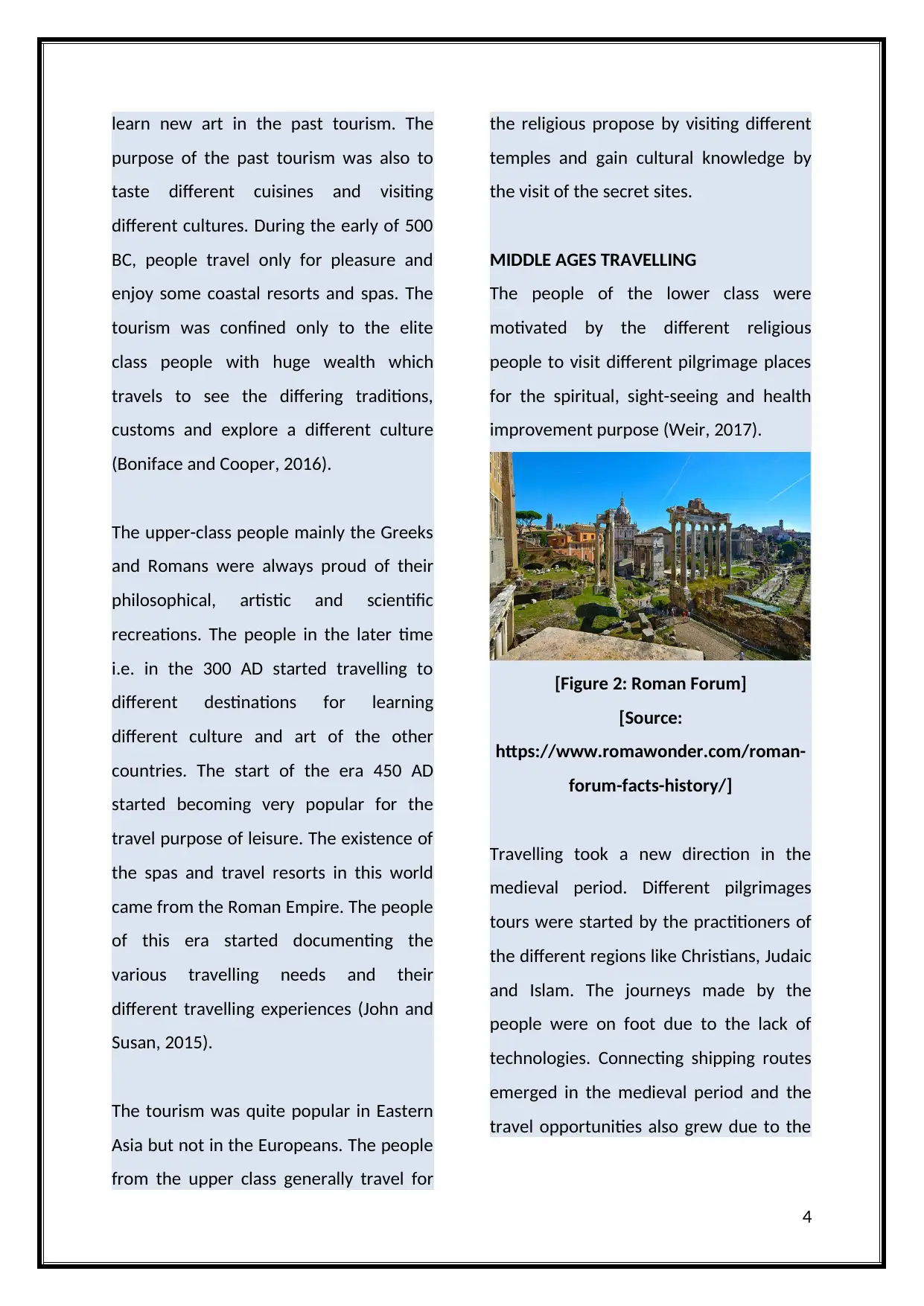
learn new art in the past tourism. The
purpose of the past tourism was also to
taste different cuisines and visiting
different cultures. During the early of 500
BC, people travel only for pleasure and
enjoy some coastal resorts and spas. The
tourism was confined only to the elite
class people with huge wealth which
travels to see the differing traditions,
customs and explore a different culture
(Boniface and Cooper, 2016).
The upper-class people mainly the Greeks
and Romans were always proud of their
philosophical, artistic and scientific
recreations. The people in the later time
i.e. in the 300 AD started travelling to
different destinations for learning
different culture and art of the other
countries. The start of the era 450 AD
started becoming very popular for the
travel purpose of leisure. The existence of
the spas and travel resorts in this world
came from the Roman Empire. The people
of this era started documenting the
various travelling needs and their
different travelling experiences (John and
Susan, 2015).
The tourism was quite popular in Eastern
Asia but not in the Europeans. The people
from the upper class generally travel for
the religious propose by visiting different
temples and gain cultural knowledge by
the visit of the secret sites.
MIDDLE AGES TRAVELLING
The people of the lower class were
motivated by the different religious
people to visit different pilgrimage places
for the spiritual, sight-seeing and health
improvement purpose (Weir, 2017).
[Figure 2: Roman Forum]
[Source:
https://www.romawonder.com/roman-
forum-facts-history/]
Travelling took a new direction in the
medieval period. Different pilgrimages
tours were started by the practitioners of
the different regions like Christians, Judaic
and Islam. The journeys made by the
people were on foot due to the lack of
technologies. Connecting shipping routes
emerged in the medieval period and the
travel opportunities also grew due to the
4
purpose of the past tourism was also to
taste different cuisines and visiting
different cultures. During the early of 500
BC, people travel only for pleasure and
enjoy some coastal resorts and spas. The
tourism was confined only to the elite
class people with huge wealth which
travels to see the differing traditions,
customs and explore a different culture
(Boniface and Cooper, 2016).
The upper-class people mainly the Greeks
and Romans were always proud of their
philosophical, artistic and scientific
recreations. The people in the later time
i.e. in the 300 AD started travelling to
different destinations for learning
different culture and art of the other
countries. The start of the era 450 AD
started becoming very popular for the
travel purpose of leisure. The existence of
the spas and travel resorts in this world
came from the Roman Empire. The people
of this era started documenting the
various travelling needs and their
different travelling experiences (John and
Susan, 2015).
The tourism was quite popular in Eastern
Asia but not in the Europeans. The people
from the upper class generally travel for
the religious propose by visiting different
temples and gain cultural knowledge by
the visit of the secret sites.
MIDDLE AGES TRAVELLING
The people of the lower class were
motivated by the different religious
people to visit different pilgrimage places
for the spiritual, sight-seeing and health
improvement purpose (Weir, 2017).
[Figure 2: Roman Forum]
[Source:
https://www.romawonder.com/roman-
forum-facts-history/]
Travelling took a new direction in the
medieval period. Different pilgrimages
tours were started by the practitioners of
the different regions like Christians, Judaic
and Islam. The journeys made by the
people were on foot due to the lack of
technologies. Connecting shipping routes
emerged in the medieval period and the
travel opportunities also grew due to the
4
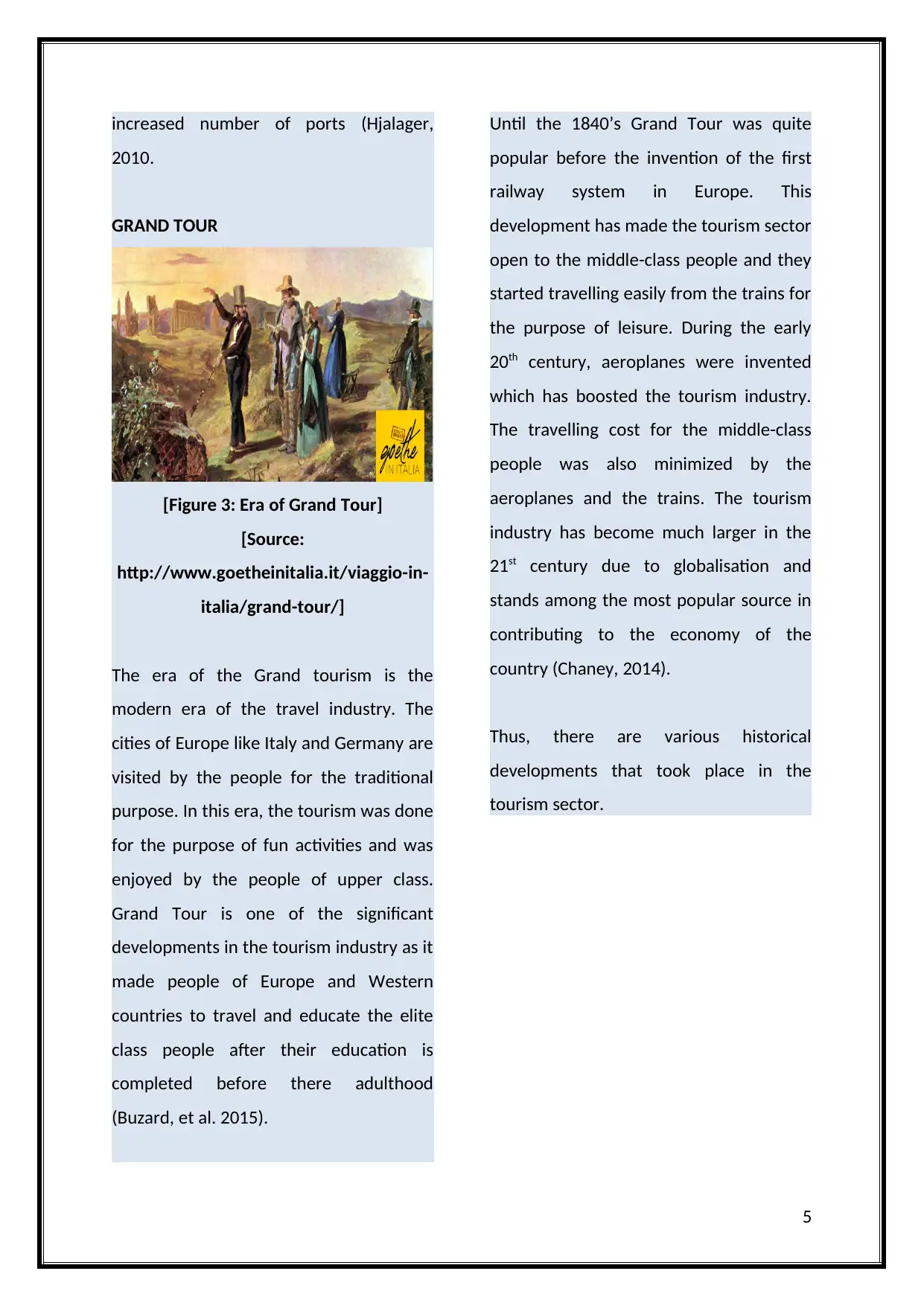
increased number of ports (Hjalager,
2010.
GRAND TOUR
[Figure 3: Era of Grand Tour]
[Source:
http://www.goetheinitalia.it/viaggio-in-
italia/grand-tour/]
The era of the Grand tourism is the
modern era of the travel industry. The
cities of Europe like Italy and Germany are
visited by the people for the traditional
purpose. In this era, the tourism was done
for the purpose of fun activities and was
enjoyed by the people of upper class.
Grand Tour is one of the significant
developments in the tourism industry as it
made people of Europe and Western
countries to travel and educate the elite
class people after their education is
completed before there adulthood
(Buzard, et al. 2015).
Until the 1840’s Grand Tour was quite
popular before the invention of the first
railway system in Europe. This
development has made the tourism sector
open to the middle-class people and they
started travelling easily from the trains for
the purpose of leisure. During the early
20th century, aeroplanes were invented
which has boosted the tourism industry.
The travelling cost for the middle-class
people was also minimized by the
aeroplanes and the trains. The tourism
industry has become much larger in the
21st century due to globalisation and
stands among the most popular source in
contributing to the economy of the
country (Chaney, 2014).
Thus, there are various historical
developments that took place in the
tourism sector.
5
2010.
GRAND TOUR
[Figure 3: Era of Grand Tour]
[Source:
http://www.goetheinitalia.it/viaggio-in-
italia/grand-tour/]
The era of the Grand tourism is the
modern era of the travel industry. The
cities of Europe like Italy and Germany are
visited by the people for the traditional
purpose. In this era, the tourism was done
for the purpose of fun activities and was
enjoyed by the people of upper class.
Grand Tour is one of the significant
developments in the tourism industry as it
made people of Europe and Western
countries to travel and educate the elite
class people after their education is
completed before there adulthood
(Buzard, et al. 2015).
Until the 1840’s Grand Tour was quite
popular before the invention of the first
railway system in Europe. This
development has made the tourism sector
open to the middle-class people and they
started travelling easily from the trains for
the purpose of leisure. During the early
20th century, aeroplanes were invented
which has boosted the tourism industry.
The travelling cost for the middle-class
people was also minimized by the
aeroplanes and the trains. The tourism
industry has become much larger in the
21st century due to globalisation and
stands among the most popular source in
contributing to the economy of the
country (Chaney, 2014).
Thus, there are various historical
developments that took place in the
tourism sector.
5
⊘ This is a preview!⊘
Do you want full access?
Subscribe today to unlock all pages.

Trusted by 1+ million students worldwide
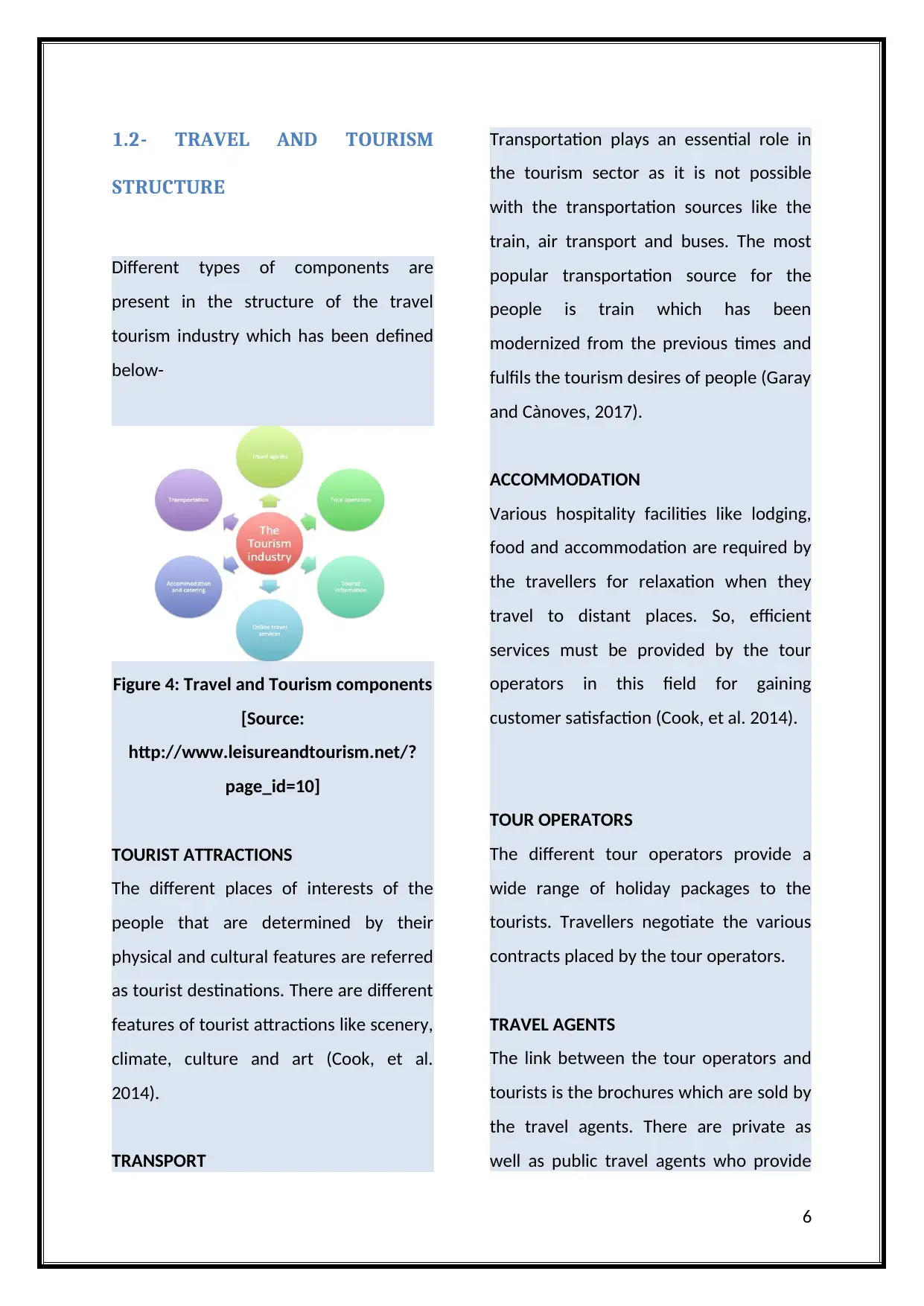
1.2- TRAVEL AND TOURISM
STRUCTURE
Different types of components are
present in the structure of the travel
tourism industry which has been defined
below-
Figure 4: Travel and Tourism components
[Source:
http://www.leisureandtourism.net/?
page_id=10]
TOURIST ATTRACTIONS
The different places of interests of the
people that are determined by their
physical and cultural features are referred
as tourist destinations. There are different
features of tourist attractions like scenery,
climate, culture and art (Cook, et al.
2014).
TRANSPORT
Transportation plays an essential role in
the tourism sector as it is not possible
with the transportation sources like the
train, air transport and buses. The most
popular transportation source for the
people is train which has been
modernized from the previous times and
fulfils the tourism desires of people (Garay
and Cànoves, 2017).
ACCOMMODATION
Various hospitality facilities like lodging,
food and accommodation are required by
the travellers for relaxation when they
travel to distant places. So, efficient
services must be provided by the tour
operators in this field for gaining
customer satisfaction (Cook, et al. 2014).
TOUR OPERATORS
The different tour operators provide a
wide range of holiday packages to the
tourists. Travellers negotiate the various
contracts placed by the tour operators.
TRAVEL AGENTS
The link between the tour operators and
tourists is the brochures which are sold by
the travel agents. There are private as
well as public travel agents who provide
6
STRUCTURE
Different types of components are
present in the structure of the travel
tourism industry which has been defined
below-
Figure 4: Travel and Tourism components
[Source:
http://www.leisureandtourism.net/?
page_id=10]
TOURIST ATTRACTIONS
The different places of interests of the
people that are determined by their
physical and cultural features are referred
as tourist destinations. There are different
features of tourist attractions like scenery,
climate, culture and art (Cook, et al.
2014).
TRANSPORT
Transportation plays an essential role in
the tourism sector as it is not possible
with the transportation sources like the
train, air transport and buses. The most
popular transportation source for the
people is train which has been
modernized from the previous times and
fulfils the tourism desires of people (Garay
and Cànoves, 2017).
ACCOMMODATION
Various hospitality facilities like lodging,
food and accommodation are required by
the travellers for relaxation when they
travel to distant places. So, efficient
services must be provided by the tour
operators in this field for gaining
customer satisfaction (Cook, et al. 2014).
TOUR OPERATORS
The different tour operators provide a
wide range of holiday packages to the
tourists. Travellers negotiate the various
contracts placed by the tour operators.
TRAVEL AGENTS
The link between the tour operators and
tourists is the brochures which are sold by
the travel agents. There are private as
well as public travel agents who provide
6
Paraphrase This Document
Need a fresh take? Get an instant paraphrase of this document with our AI Paraphraser
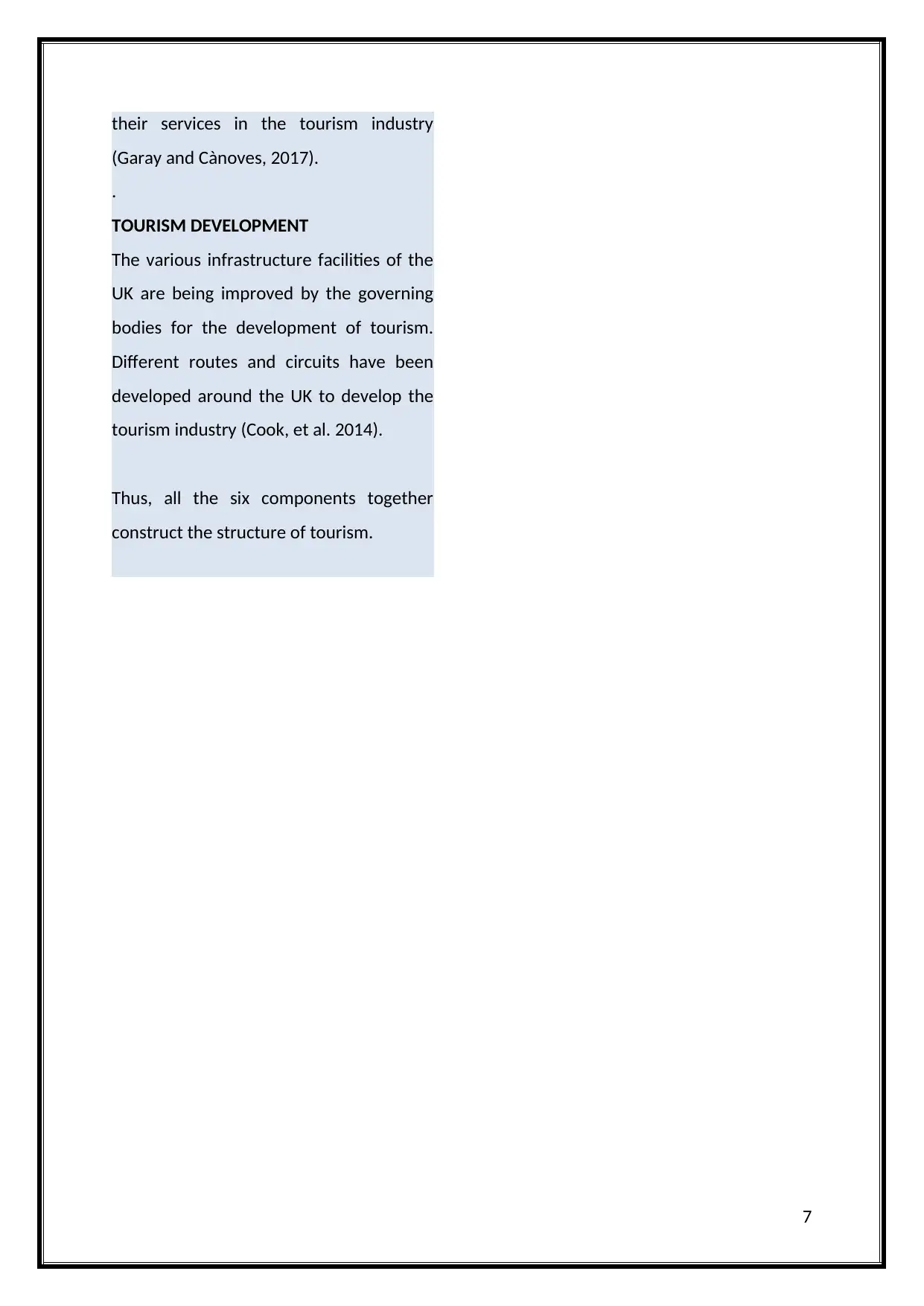
their services in the tourism industry
(Garay and Cànoves, 2017).
.
TOURISM DEVELOPMENT
The various infrastructure facilities of the
UK are being improved by the governing
bodies for the development of tourism.
Different routes and circuits have been
developed around the UK to develop the
tourism industry (Cook, et al. 2014).
Thus, all the six components together
construct the structure of tourism.
7
(Garay and Cànoves, 2017).
.
TOURISM DEVELOPMENT
The various infrastructure facilities of the
UK are being improved by the governing
bodies for the development of tourism.
Different routes and circuits have been
developed around the UK to develop the
tourism industry (Cook, et al. 2014).
Thus, all the six components together
construct the structure of tourism.
7
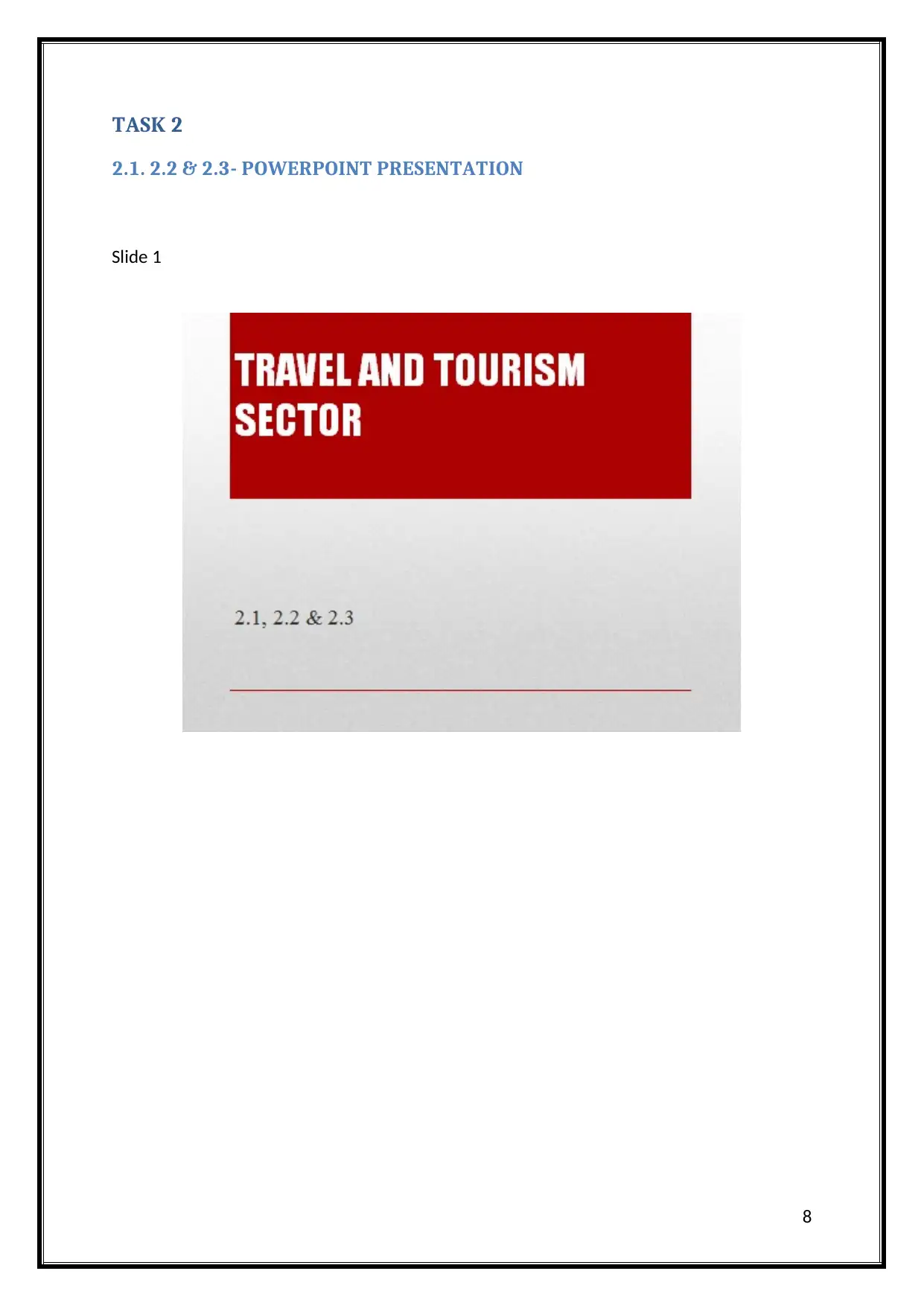
TASK 2
2.1. 2.2 & 2.3- POWERPOINT PRESENTATION
Slide 1
8
2.1. 2.2 & 2.3- POWERPOINT PRESENTATION
Slide 1
8
⊘ This is a preview!⊘
Do you want full access?
Subscribe today to unlock all pages.

Trusted by 1+ million students worldwide
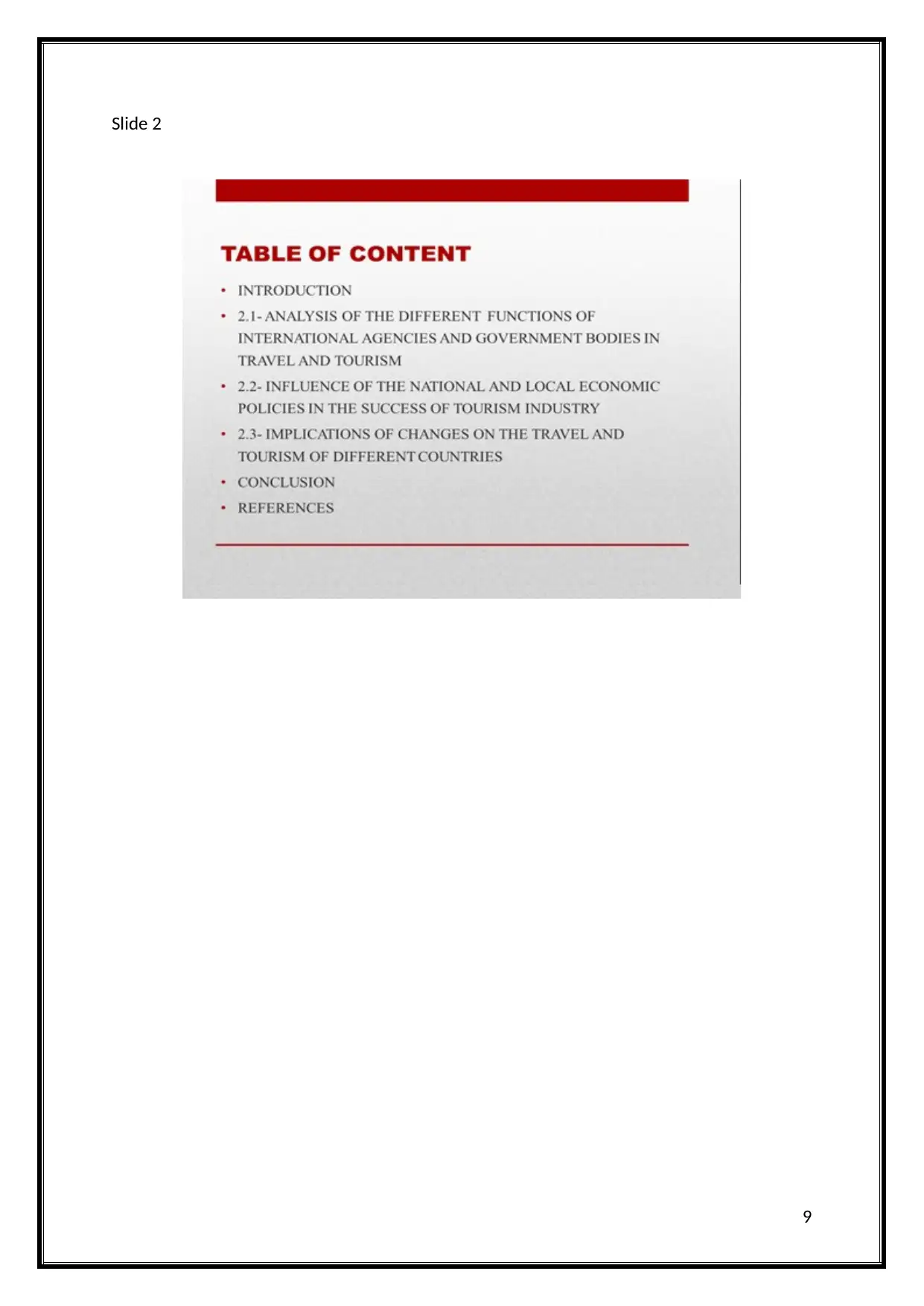
Slide 2
9
9
Paraphrase This Document
Need a fresh take? Get an instant paraphrase of this document with our AI Paraphraser
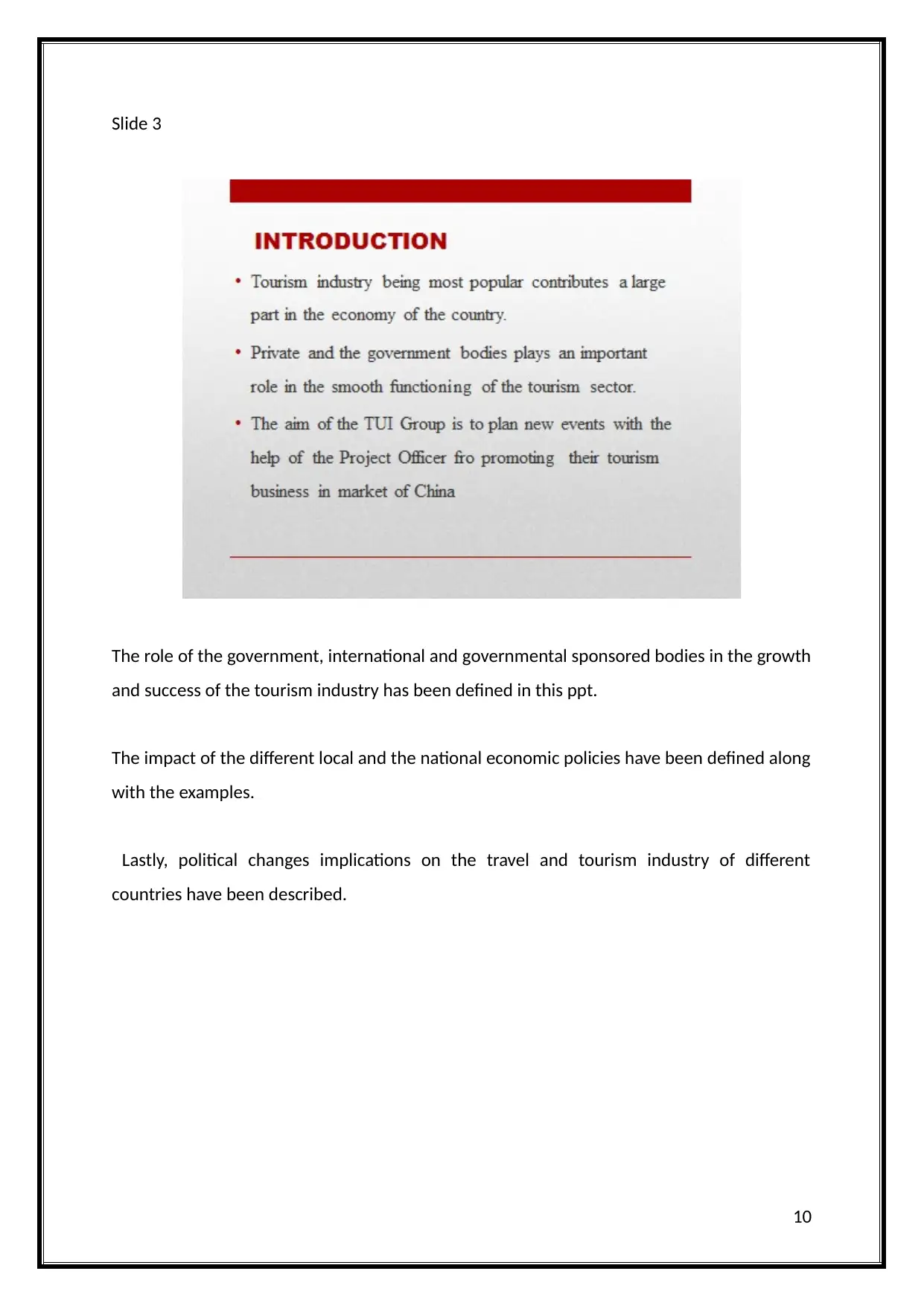
Slide 3
The role of the government, international and governmental sponsored bodies in the growth
and success of the tourism industry has been defined in this ppt.
The impact of the different local and the national economic policies have been defined along
with the examples.
Lastly, political changes implications on the travel and tourism industry of different
countries have been described.
10
The role of the government, international and governmental sponsored bodies in the growth
and success of the tourism industry has been defined in this ppt.
The impact of the different local and the national economic policies have been defined along
with the examples.
Lastly, political changes implications on the travel and tourism industry of different
countries have been described.
10
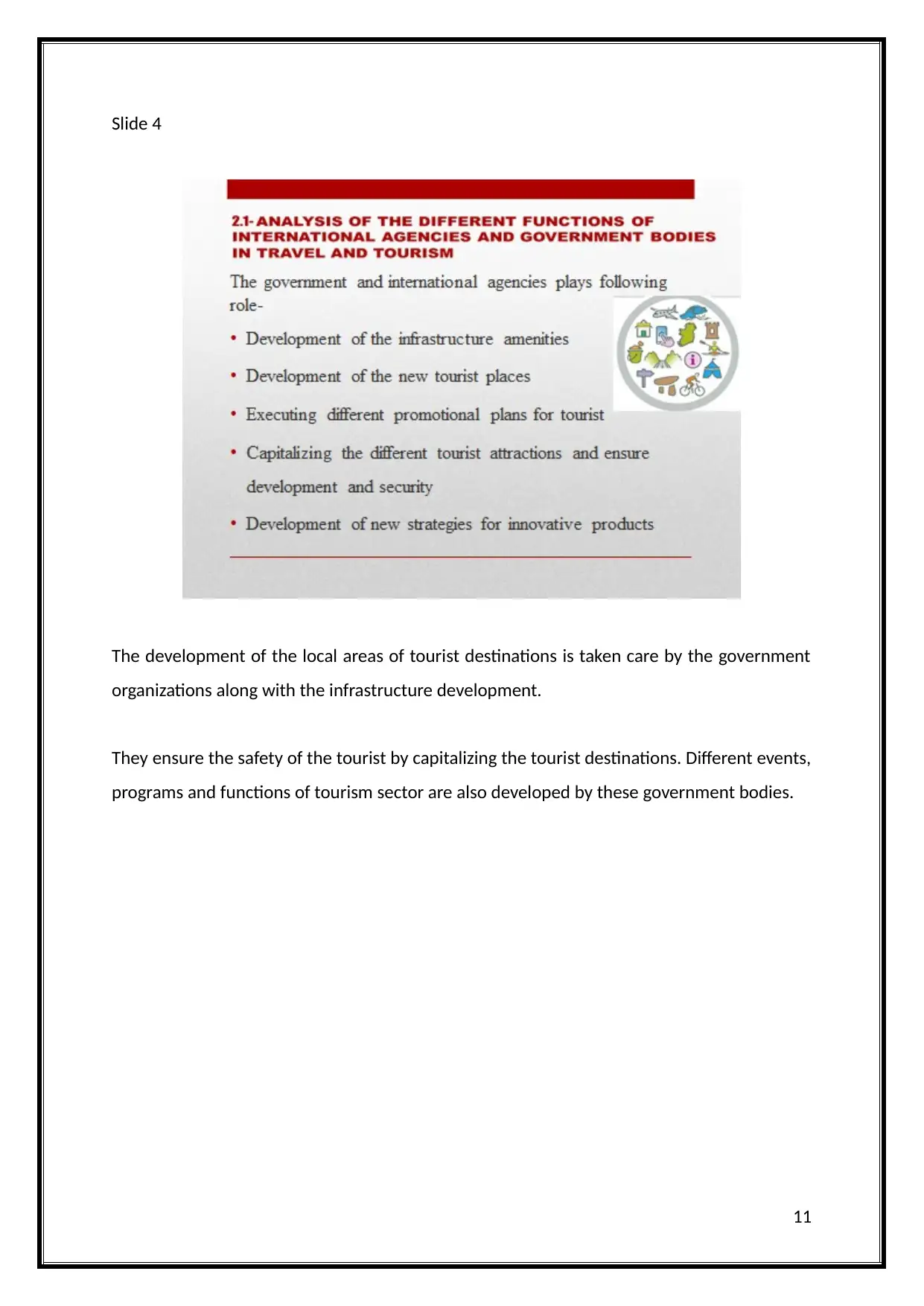
Slide 4
The development of the local areas of tourist destinations is taken care by the government
organizations along with the infrastructure development.
They ensure the safety of the tourist by capitalizing the tourist destinations. Different events,
programs and functions of tourism sector are also developed by these government bodies.
11
The development of the local areas of tourist destinations is taken care by the government
organizations along with the infrastructure development.
They ensure the safety of the tourist by capitalizing the tourist destinations. Different events,
programs and functions of tourism sector are also developed by these government bodies.
11
⊘ This is a preview!⊘
Do you want full access?
Subscribe today to unlock all pages.

Trusted by 1+ million students worldwide
1 out of 32
Related Documents
Your All-in-One AI-Powered Toolkit for Academic Success.
+13062052269
info@desklib.com
Available 24*7 on WhatsApp / Email
![[object Object]](/_next/static/media/star-bottom.7253800d.svg)
Unlock your academic potential
Copyright © 2020–2025 A2Z Services. All Rights Reserved. Developed and managed by ZUCOL.





